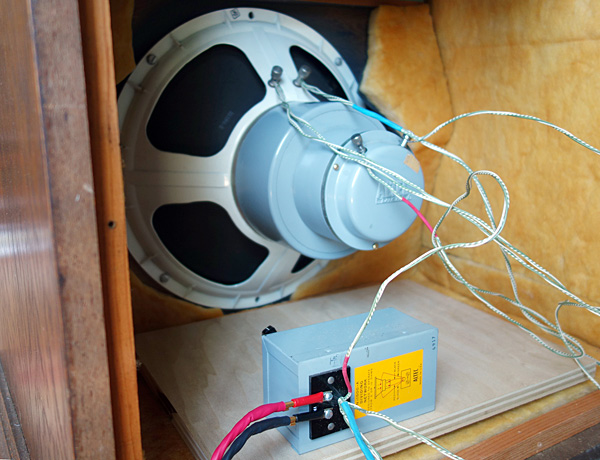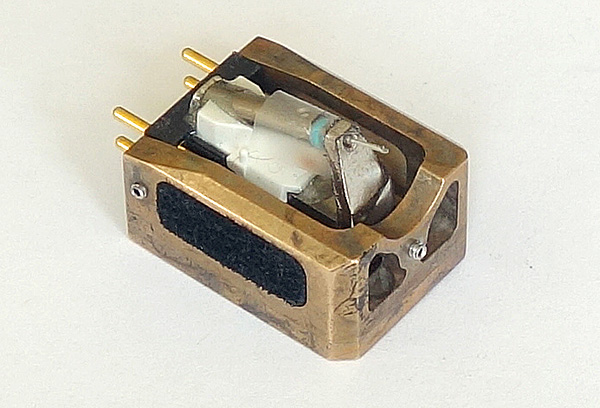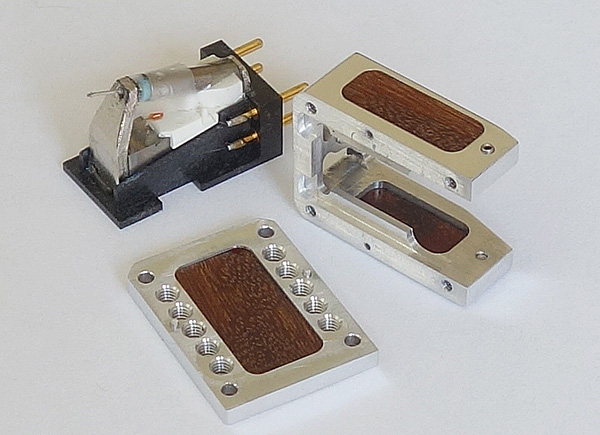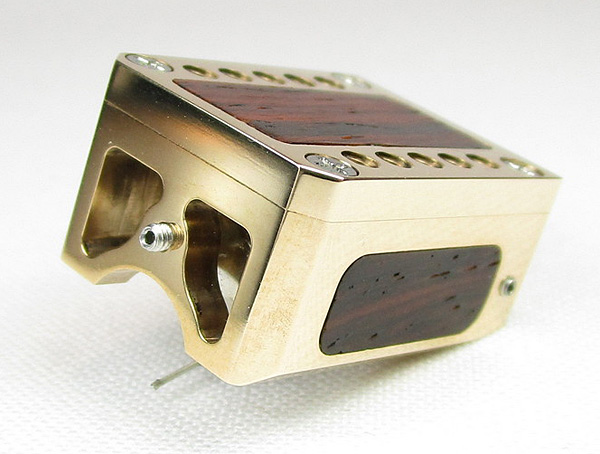| Columns Retired Columns & Blogs |
Godzilla .... Godzilla :-) .........
Driver, stop here
The sound of the 604E in the Flamenco cabinet was very interesting, and there was much to say wow about.
During the first few selections I played through my pair—mostly piano recordings, mostly CDs—it seemed to me like a band of frequencies in whatever range gives warmth and meat to notes in the piano's right hand was missing, yet there was no brightness, lightness, or etch: Music sounded compelling, and prettily, colorfully detailed. After about three hours playing a piano CD on repeat, I switched gears and played some selections from the CD box set Sweet Dreams: The Anthology by Roy Buchanan (2CDs, Polydor 314 517 086-2). What impressed me was how the recorded instrumentalists sounded like a band. Things jelled, musically. The players sounded like they were playing together, listening to each other, watching for each other's cues. And at the end of "Pete's Blue," the sound of the drummer playing a couple of beats on what may have been a timbale, or perhaps just a ride tom struck near its rim, was unusually present and, yes, meaty—but not as scary-meaty as the sound he made when he tapped a stick on the crown of one of his cymbals after the song was over: Holy shit!

After just two days with the 604Es in my system, I played the stereo version of the recording by Artur Rubinstein, Fritz Reiner, and the Chicago Symphony Orchestra of the Brahms Piano Concerto No.1 (LP, RCA/Classic Records LSC-1831). Apart from his Strauss and Bartók, I'm not at all a Reiner fan, nor do I consider RCA's stereo classical records to be the best stereo classical records ever made—and this record had never impressed me as anything but perfunctory, musically and sonically. Yet suddenly, through these speakers, that fat, womanizing old Hungarian sounded like Superman—like he'd throw a station wagon at the orchestra if they failed to play as passionately as he wanted them to. The players sounded like they were scared out of their wits, but no less virtuosic for the threat. In the space of 45 minutes, that LP became my favorite Brahms First, surpassing even the one by Curzon, Szell, and the London (better and altogether more powerful soloing, but with an orchestra led by a conductor whose mind seems to wander when it shouldn't).
Those were the good things.
But through the 604Es, Leroy Vinnegar's double bass on "Chelsea Bridge," from Gerry Mulligan Meets Ben Webster (mono LP, Verve MG V-8343-A), wasn't nearly as tautly impactful as through my unadulterated Flamencos and their 416Z woofers. Likewise, Art Taylor's wonderful drumming on Dexter Gordon's "Tanya," from One Flight Up (LP, Blue Note/Cisco 84176) sounded more staid than it should have.
It's possible that the less-tight bass could be improved with a different style of loading than that provided by the Flamenco enclosure, best characterized as undamped aperiodic—improved but probably not made entirely right. Of more concern was the 604E's drastic increase in detail retrieval, remarkably accomplished without additional brightness. On the one hand, it was sort of cool that I could suddenly hear, from across the room, the application of automatic double-tracking to a backing choir, midway through the chorus of a song on Elton John's Madman Across the Water (LP, Uni/DCC LPZ-2004)—which, frankly, didn't add to my enjoyment of the music, and in fact depressed me with the realization of how overcalculated and unspontaneous the production as a whole now seemed to be.
Worse still was the fact that the details my 604Es so eagerly retrieved included a vigorous dose of LP surface noise. On one very noisy record, ticks and pops filled the space in front of me like black flies in May while camping in the Adirondacks. In my experience, in my room, audibility of surface noise is always a sign that something is wrong—with my system, not the record. Over the course of many months and too many minor adjustments and equipment choices to recount, I have tuned my system to do a much better than average job of shrugging off ticks and pops. When they start to pop (sorry) up again, and particularly when they start appearing all over the damn place, spatially, I know that things have gone tits-up. And so it was here.
Do 604Es need a bigger room? Or a smarter enclosure? Or untold months of running in? Or different electronics? Or something else? Quite possibly, yes: My respect for these titanically well-engineered drivers, so often used as recording-studio monitors, has not dimmed, and I will never do less than cheer those of you who enjoy them at home. But I have learned from this tentative experience that monitors such as these are not for me—and I intend to set them aside for now. I believe that, in the days ahead, my time is better spent on speakers I already know and love, and that is what I intend to do.
What Can They Do For An Encore?
I don't know who started the trend of making and selling replacement bodies for the Denon DL-103—a great-sounding, budget-priced ($299) moving-coil phono cartridge that's been in production since 1962—but it appears to be going strong. The first one I remember hearing about was the bronze aftermarket body made by LignoLab of Germany. The first such product I tried was the first version of the Zu Audio DL-103, which I wrote about in the December 2007 Stereophile.

Ten years after that, in the August 2017 Stereophile, I wrote about the Montreal-based company Audio MusiKraft (footnote 2) and reviewed a sample of the Denon replacement body they machine from an alloy of aluminum and lithium and fit with three tiny wooden panels ($429).4 (They also offer a less expensive version made from aluminum, and a more expensive one made from magnesium, all with various extra-cost finish options.) I described how impressed I was with the MusiKraft's build quality and with the more refined yet no-less-impactful sound it coaxed from the Denon; that said, I erred when I wrote that the MusiKraft body grips the denuded Denon DL-103 "by means of a very precise, very snug friction fit." I discovered that mistake only recently, while disassembling my review sample so I could install the Denon into a new version of the MusiKraft.

When I received my first MusiKraft review sample, I accepted the company's offer to install it themselves, on a DL-103 sample of their own. I shouldn't have—not only because it cheated you of being told how dead easy the procedure is (footnote 3), but because it cheated the MusiKraft body out of the praise it deserves for being so ridiculously well-engineered and precisely machined. To remove the Denon cartridge's stock plastic body shell is to reveal the thin, flat, and surprisingly uniform plastic platform to which the motor is bonded—and the two precision-machined halves of the MusiKraft shell clamp tightly around that platform. The cartridge is held safely, tightly in place, and there's no need for the epoxy or other adhesives upon which most if not all other aftermarket Denon bodies appear to depend.

That's what I saw for myself while installing my review sample of MusiKraft's new bronze body for the DL-103 (which is available only with a Denon DL-103 installed: $1979 for the basic polished version, with various patinas available at extra cost). To say that bronze as a material has a cult following among the audio cognoscenti is to sound snarkier than I wish to; suffice it to say that bronze horn throats and other fittings, tonearm boards (I have one of those), record platters, and woofer baskets pop up from time to time, usually from companies I associate with good (read: musical, impactful, involving, non-hi-fi-sounding) products.
Of greater immediate importance is bronze's higher-than-aluminum mass: The lightweight plastic headshell on the DL-103—a distinctly low-compliance cartridge—never impressed me as making a great deal of sense. The MusiKraft bronze shell weighs 13.1gm without the cartridge, 20.6gm with. Compare that to the aluminum-lithium version I wrote about earlier, which weighs 3.93gm without the cartridge, 11.5gm with. In most installations, combined with the Denon's relatively stiff suspension, that extra mass at the business end of the arm will likely result in a more optimal resonant frequency (foonote 4).
I set about using the newly bronzed cartridge to play some of the records I'd used in my first MusiKraft review— in particular the 1960 recording of Vivaldi's The Four Seasons by Societa Corelli (RCA LSC-2424) and the Incredible String Band's Liquid Acrobat as Regards the Air (Island ILPS 9172). Both seemed very slightly more nuanced and more impactful than they had before—perhaps as a consequence of the cartridge's now-more-propitious "weighting," perhaps because bronze really "sounds" better, perhaps neither.
Unlike many other stereo carts, the MusiKraft-equipped Denon was a fine mono cartridge in a pinch: when you want to hear good mono playback but you have neither the time nor the inclination to futz around changing cartridges. I put on "Straight Street" from the 1956 classic John Coltrane (Prestige/ Analogue Productions LP 7105) and was thrilled not only by the weight of Sahib Shihab's baritone sax and the force behind Paul Chambers' bass but also the really superb sense of drive this cartridge allowed. Yes, I suppose my EMT OFD 25 true-mono pickup head would have been even more impactful and a far sight juicier, too, but this was an excellent port in the storm.
The bronze version of the MusiKraft Denon is still new to me, and I hope, with the manufacturer's indulgence, to continue playing with it for a while. But my first listens have been more than encouraging enough to recommend this combination, especially in record players that are tuned for low-compliance cartridges.
Footnote 3: When that review went up on stereophile.com, yet another friendly reader, named rockdc, drew my attention to how easy it is to remove the Denon's stock body—something else I might have benefitted from. Maybe I should spend more time reading my mail?
Footnote 4: Then again, be careful: With the Acoustical Systems Arché headshell, the bronze-bodied Denon was heavier than my EMT 997 tonearm's counterweight could cope with. I had to revert to a simpler, lower-mass aluminum headshell.

Godzilla .... Godzilla :-) .........

He is coming after those digital people :-) .........

Even the transistor people are not immune :-) ........

You (RS) got my vote for Prime Minister of Canada :-) ..........

...between the birth of Art Dudley and that of Godzilla, birthdate is not one of them. In Godzilla vs. King Ghidorah, it’s revealed that an Imperial Japanese Army unit discovered a still-living dinosaur on an island in 1944. This dinosaur (retroactively termed Godzillasaurus) was eventually exposed to radiation from an American nuclear bomb test and mutated into the city stomper we all know and love.
However, it is firmly established that they both were hatched from eggs and enjoy listening to Bruckner in their spare time.

And, they both like Eggs Sardou :-) .........

... speakers and a better phono cartridge if he truly prefers the Rubinstein/Reiner or Curzon/Szell interpretations of the Brahms Piano Concerto No.1.
He might, instead, wish to listen to the versions by Serkin/Ormandy or Rubinstein/Haitink, not to mention Barenboim/Barbirolli or Gelber/Kempe.
Could we please have JA1 arrange to measure AD's Altec speakers (as driven by his tube amps) in order to determine whether or not any genuine advances have been made in speaker design and technology since around the time that AD took his first breath?
And, would it be at all possible to refrain from using the word curate unless the reference is to a member of the clergy who is coincidentally an audiophile?

Curate suggests a supporting member of the Vinyl Religion. ( probably accurate in this case )
but....
Curate is also a verb meaning to select & organize items of a collection.
Mr.AD fits both meanings, he certainly has interesting things to relate and fascinating experiences. He doesn't ever seem to set-off the bullshit detector or say things that seem a little >))))'> ( like I might say and do, from time to time )
Tony in Venice
ps. I too wonder if Transducer Performance has improved over these Decades. I suspect there have been engineering advances in materials, techniques, magnet Engines, Voice coil cooling, dynamic range and improved overall sound quality. ( but I can't prove it like JA could attempt )

If we could measure the intrinsic nature of sound from devices like this we'd still have to correlate that data back to sound. Two things we cannot yet do.
Measured SPL and power - recorded speaker data - is good for engineering but vastly less so for informing good audio.

Maybe he should check out the Emil Gilels/Berliner Philharmoniker/Eugen Jochum recording of Brahms' First [and Second] Piano Conceri on DGG. Better sound, about as well played by all concerned of all the versions heard so far. Not to forget the beautifully played, beautifully recorded Claudio Arrau/Bernard Haitink/Royal Concertgebouw Orchestra recordings of Brahms' PC on what used to be Philips.

Two Grand seems a rather low investment if this transducer is worth owning and remanufacturing.
So, if Mr.Dudley has one, it must be worth owning, right?
Why is a useful opinion missing from this article?
My point is that a person doesn't need to spend $15,000 for a Phono Transducer, as is often presented by Analog writers. Old phono Cartridges can be rebuilt.
Tony in Venice
ps. is this a teasing

Gojira.
I have two family members that live in Japan, so I have to remember the "proper" way to say it.
There are many references to his Japanese name in the current film, in fact Ken Watanabe uses the term more than half of the time.
Born in late 1955, I had scale models of all of the Toho creatures in my bedroom. Good times...

He's the color of Grimace and likes good sound,
He likes stereo platters not music in the round.
Helpless people on subway trains
Scream, bug-eyed, as they read his 'Listening' column.
He picks up a pick up and he cues it back down
As he wades through his records just outside of town...
Oh, no, It's a record with banjo!
No, No! Dudzilla
Oh, no! That Bluegrass has got to go!
Go, go, Dudzilla!


Beyond Our Control? :-) ........

...Blue Oyster Cult. (In case you didn't know.)

I knew about that song by Blue Oyster Cult :-) ......

There was a TV series named BOC :-) ........

Even AOC is BOC :-) ..........

Could AD review the new Mark Levinson No.5101 CD/SACD player/DAC ($5,500) and compare it with the Hegel Mohican ($5,000, Stereophile Class-A), which can only play CDs? :-) .........

Should a pic of my face one day be superimposed on that of a Volkswagen Beetle, would you dedicate lyrics to me to the theme of Herbie the Love Bug?
A boy can dream, right?
:-)

I think Mr. Reichert may have dibs on all things "Herbie."
;-D
I could put you down for the Clampett's song!
Gilligan's Island theme?
Cheers, amigo.

...dibs on all things Herbie."
Dam! You're probably right.
In that case, if you see my face on any of the cast members of Gilligan's Island or Beverly Hillbillies (ooh, fingers crossed it turns up on a shotgun-wielding Granny Moses), please proceed with your alternate plan.
I'm sure it will be splendid.
Cheers back, amigo.

Granny Moses likes to sing "Fuh You" :-) .........

So would it be a lot cheaper to just add weight to your Denon DL103 to increase mass and beef up the sound?
Is it the fancy body construction OR is it just more mass that improves this cartridge?
I DO know (I currently own eight of the Denons in differents setups)a DL103 LOVES MASS.
The needle is so stiff it takes a LOT of weight to make it behave.
Somebody should compare an expensive add-on "body" to a simple weight and thus determine what causes the better sonics.
My own approach is to spend a few bucks on a better stylus and cantilever to improve top end detail retrieval.
As for fancy new bodies I don't go there.
I use a heavy headshell and an extra 8 grams of headshell weights.
Cost was about $30 bucks.

Or maybe you could tape a couple of quarters to the headshell.

Actually there are precision weights that fit on my headshell and it is threaded to hold these.
But go ahead and put quarters on your own machine.
Nice set you have there, ha ha.

What is it you have?
It doesn’t sound familiar!
I learn new stuff every day.

Nothing is going to fix the vast bulk of discs that are defective. Nothing is going to change the loss of energy in the groove as the stylus approaches the deadwax. Right now, I have no LPs, no turntables. Nothing is going to convince me that I want another LP or another turntable.

... fixed-coil cartridge - if you want your LP playback to sound most like the master (tape) recording.
http://www.regonaudio.com/Stanton881AudioTechnicaATML70.html
https://www.sound-smith.com/articles/fixed-coil-vs-moving-coil-why-make-jump-different-technology

I have a similar question. I am not an expert (and the question may make that clear). I have read that adding mass to the cartridge body does not solve the inherent problem with low compliance cartridges such as the Denon 103 and low or medium mass tonearms. It is often compared to adding pennies to the headshell. As I read (somewhere) the overall mass of the tonearm is key to getting the maximum out of the cartridge/stylus. Adding weight to each end is not the same as having weigh distributed throughout a tonearm. Am I wrong? I would love to be wrong so I could use a 103 on my LInn Ittok.

The typical screw on removable headshell often comes with a threaded top just for modifying mass.
This will , of course, require a different heavier counterweight but these simply screw on the back of your arm or you can make your own screw on add-ons.
My direct drive Technics has all the above plus the arm tube is deadened with silicone shrink wrap.
And the arm sits in a tub of silicone damping fluid.
The mass of the arm is now around 26 grams which makes a Denon DL103 really SING.
Putting the cartridge inside a wood or metal body just seems unnecessary.
Anybody ever do a test to see if it was just the mass that helps a Denon?
If all you need is a high mass arm that really isn't a problem that the cartridge is responsible for making.
My two cents.

... tub of silicone damping fluid? Or, is if fitted with some sort of outrigger with a little paddle that sits in a container of silicone damping fluid - such as the device KAB sells?

There are a few avenues / variables you could still investigate. For a start, the N1500-A is not the be-all / end-all of crossovers (sorry, Altec-Lansing). If you are really serious, find yourself a Mastering Labs crossover set (although now we're talking some cash outlay), alternately, you could roll something a bit simpler, such as the JELabs 2-way (http://jelabs.blogspot.com/2018/01/altec-2-way-xo-redux.html?q=altec+crossover) - just change the 16uF to 14uF, the 1mH to 1.5mH, and the 4uF to 3uF for the 604E.
Also, it's an unfortunate truth that even though the 604 uses a 15" woofer, it still needs bass reinforcement. A good subwoofer or a couple of bass bins can only help.
Best of luck.
Also, it's an unfortunate truth that even though the 604 uses a 15" woofer, it still needs bass reinforcement. A good subwoofer or a couple of bass bins can only help.